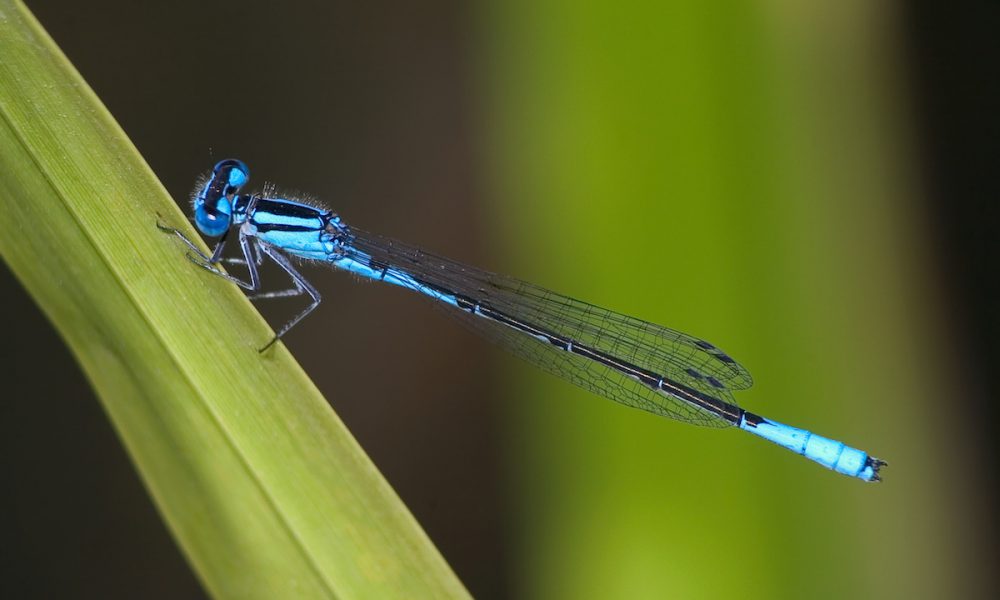
Yes, you heard correctly – Damselflies. A Damselfly or a Dragonfly is a predatory insect of the order Odonata. Odonata is an order of carnivorous insects which encompass the dragonflies and the damselflies. The Odonata form a clade, which has existed since the Triassic. Dragonflies are generally larger, and perch with their wings held out to the sides; damselflies have slender bodies, and hold their wings over the body at rest.
Damselflies
Appearance
In appearance, Damselflies are quite similar to the Dragonflies that belong to the Anisoptera suborder, but are comparatively lighter in build. The Damselflies are believed to exist from the period of the Lower Permian, and are widely distributed on every continent besides Antarctica.
Behavior
Odonates are active on pleasant sunny days and found near fresh water sources.
Body
The body structure of a Damselfly and a Dragonfly is much alike. The eyes are compound like the Dragonflies, but are comparatively smaller and widely separated. The forehead is present above the eyes. They have three eyes known as Ocelli, which helps them to measure the intensity of light. The two small antennae over the head are to measure the air speed. The wingspan of this insect ranges between 18mm to 19cm. The male Damselfly is more brightly colored. The female is cryptically colored, plain and difficult to recognize. Color patterns vary as do wing designs and lengths can run as long as 5 inches.
“Bulging eyes are set to the sides of the head and each contains thousands of honeycomb-shaped lenses providing excellent vision with moving targets. Six legs are utilized for grabbing pray or clasping onto reeds and plants. Wings are noticeably veined and appear as two pairs of straight appendages emanating from the spine. When at rest, Dragonflies will generally lay their wing pairs flat while Damselflies will typically hold their more elegant tear drop-shaped wings close together and away or above the body. Odonates are quick fliers that can seem to hover at times and they will even mate in mid-air (the male and female flying about in tandem). A single female can lay one egg or several and these deposits are generally found in or near water sources. Life cycles of Odonates are variable – some completing them in a single month while others cover years,” explains Insect Identification.
Food
Damselflies feed on flies, mosquitoes, and other tiny insects. They often hover among low vegetations and grasses, eating the prey found on the leaves and stems by picking them with their thorny legs. Typically, they do not feed at night.
There are a total of 21 North American Dragonflies and Damselflies in the Insect Identification database. Entries are listed below in alphabetical order (A-to-Z).
- Blue-fronted Dancer
- Common Green Darner
- Common Sanddragon
- Common Whitetail Skimmer
- Dragonhunter
- Eastern Amberwing
- Eastern Pondhawk
- Ebony Jewelwing
- Familiar Bluet
- Giant Darner
- Great Blue Skimmer
- Halloween Pennant
- Orange Meadowhawk
- Red Saddlebags
- Slaty Skimmer
- Wandering Glider
- Western Flying Adder
- Widow Skimmer
If you see any evidence of unwanted insects in your home or business, contact a pest control company immediately to take care of the issue.
Houseman Services is the only complete service company in the Athens, GA area. We provide Weed control, fertilization, shrub care, mulch & pine straw, sod, annual plantings, irrigation, and commercial & residential lawn maintenance. We are also state certified and licensed in wood destroying organisms (termite control), household pest control, public heath, and turf & ornamental weed control. We are licensed to control and treat mosquitoes, termites, all pest problems and turf & ornamental weed control. Contact the professionals at Houseman Services and set up a free inspection of your yard. We have been servicing homes and businesses in the Athens, Clarke County area since 1985!